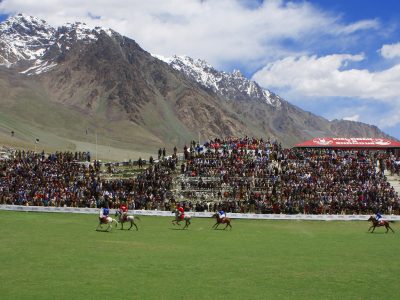Sia Kangri Mountaineering Expedition
Sia Kangri, standing proudly at 7,422 meters (24,350 ft), is a majestic mountain situated in the Baltoro Muztagh, nestled within the Karakoram range. This imposing peak marks the border between Pakistan and China, and intriguingly, about a kilometre southeast lies the tri-point where territories controlled by India, Pakistan, and China converge. The surrounding territories are hotbeds of dispute, adding a layer of complexity to the region.
Sia Kangri Weather: Best Time to Visit
Spring (April to June):
-
- Mild temperatures range from 5°C to 15°C.
- Clear skies and thawing landscapes.
- Ideal for trekking and mountaineering.
Summer (July to September):
-
- Pleasant temperatures range from 10°C to 20°C.
- Peak trekking season with longer daylight hours.
- Best for summit attempts and panoramic views.
Autumn (October):
-
- Moderate temperatures range from 5°C to 15°C.
- Fading snow reveals stunning landscapes.
- Ideal for those seeking a quieter trekking experience.
Winter (November to March):
-
- Cold temperatures, often dropping below freezing.
- Snow-covered terrain and challenging conditions.
- Recommended for experienced mountaineers seeking a winter ascent.
Location:
Located in the heart of the Karakoram Mountains, Sia Kangri finds its place in the Baltoro Muztagh, a sub-range of the Karakoram. Positioned near the Shigar village in Gilgit-Baltistan, Pakistan, this peak is not only the world's 63rd highest but also claims the title of Pakistan's 25th highest, reaching an elevation of 7,422 meters (24,370 ft). Its summit, acting as a tri-point, is shared by Pakistan, China, and India, making it a geographical wonder.
Expedition History:
Sia Kangri's summit was first conquered in 1934 by the International Himalaya Expedition, led by the Swiss-German mountaineer Günter Dyhrenfurth. Notably, Hettie Dyhrenfurth, part of the summit party, achieved the women's world altitude record during this expedition—a record that endured for two decades. Recently, Pakistan has opened the doors of Sia Kangri to mountaineers and climbers, granting they secure permission from Islamabad for the exhilarating ascent.
Tri-Point Summit:
Sia Kangri's unique distinction lies in its tri-point summit, shared by Pakistan, China, and India. The geopolitical complexity adds an intriguing layer to the climb, as the surrounding territories are marked by dispute. This tri-point summit, perched at an altitude of 7,422 meters, stands as a symbol of the interconnectedness of these nations through the towering presence of Sia Kangri.
TOUR Detail:
Day 1:
- Fly from Islamabad to Skardu.
- Drive to Askole, the last village before the trek.
- Camp overnight in Askole.
Day 2:
- Trek from Askole to Jhola.
- Camp overnight in Jhola.
Day 3:
- Trek from Jhola to Paiju.
- Camp overnight in Paiju.
Day 4:
- Trek from Paiju to Khoburtse.
- Camp overnight in Khoburtse.
Day 5:
- Trek from Khoburtse to Dunde.
- Camp overnight in Dunde.
Day 6:
- Trek from Dunde to Goro II.
- Camp overnight in Goro II.
Day 7:
- Trek from Goro II to Concordia.
- Visit K2 Base Camp.
- Camp overnight in Concordia.
Day 8:
- Rest and acclimatize at Concordia.
Day 9:
- Trek from Concordia to Camp III on Sia Kangri.
- Camp overnight at Camp III.
Day 10:
- Summit Sia Kangri and descend to Camp III.
- Camp overnight at Camp III.
Day 11:
- Trek from Camp III to Concordia.
- Camp overnight in Concordia.
Day 12:
- Trek from Concordia to Goro II.
- Camp overnight in Goro II.
Day 13:
- Trek from Goro II to Dunde.
- Camp overnight in Dunde.
Day 14:
- Trek from Dunde to Khoburtse.
- Camp overnight in Khoburtse.
Day 15:
- Trek from Khoburtse to Paiju.
- Camp overnight in Paiju.
Day 16:
- Trek from Paiju to Jhola.
- Camp overnight in Jhola.
Day 17:
- Trek from Jhola to Askole.
- Camp overnight in Askole.
Day 18:
- Drive to Skardu.
- Fly from Skardu to Islamabad.











